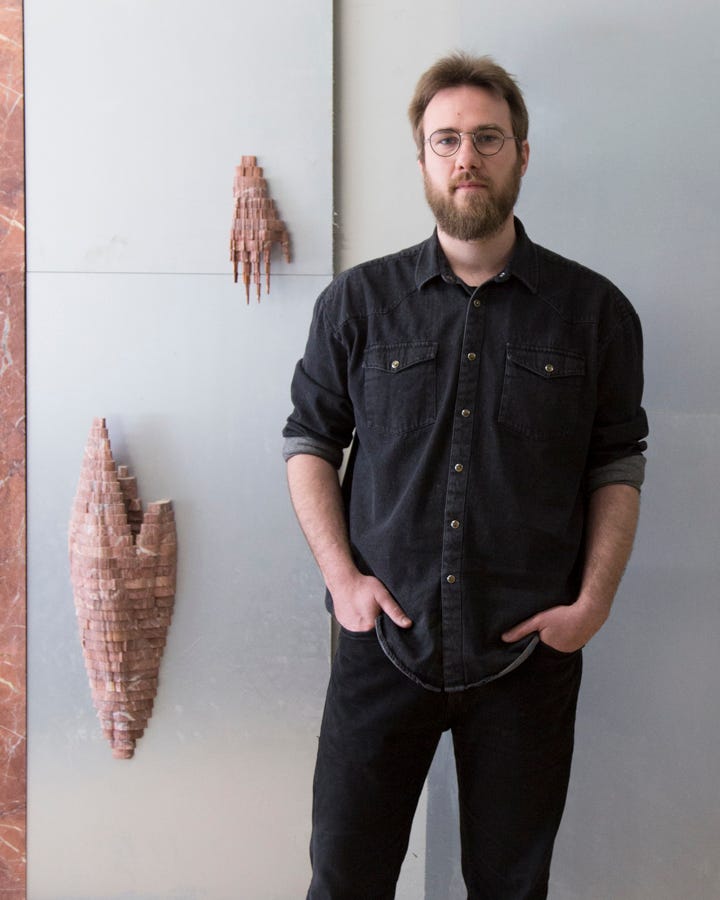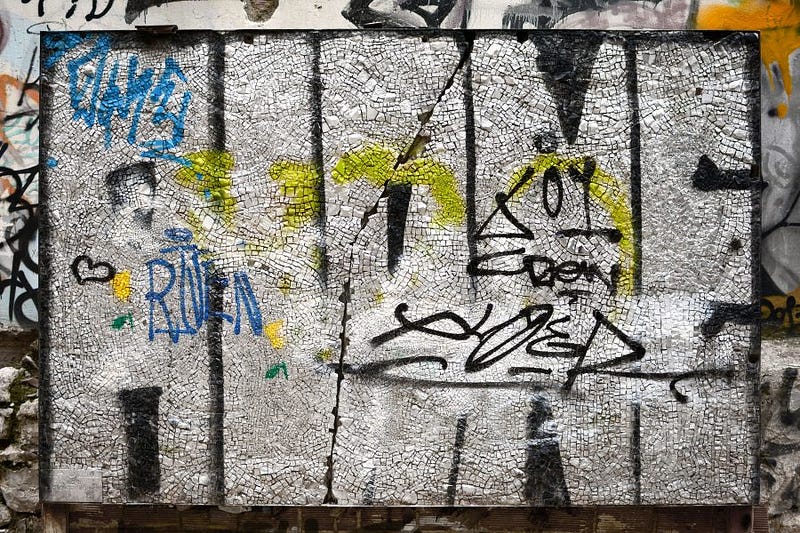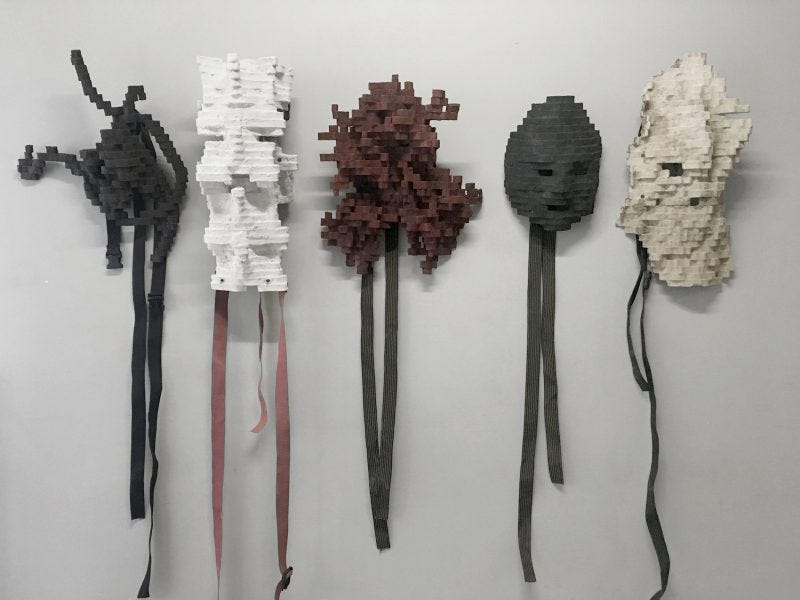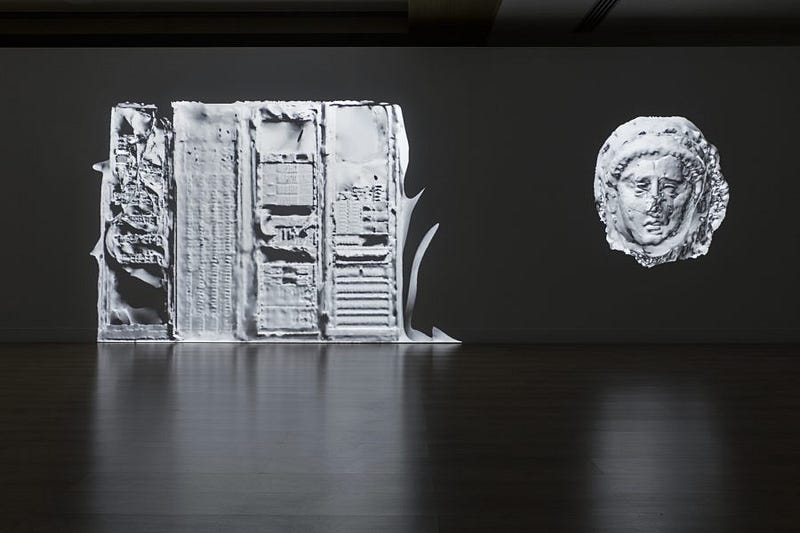04.03.2020
Greece’s Gifts — and Burdens: The Geneaology of Petros Moris
Εικαστικες Τεχνες
Γλώσσα πρωτότυπου κειμένου: Αγγλικά
On the day we meet, Petros Moris is waiting for me at the cafe in front of Athens’ National Archaeological Museum. A hundred meters away, many of the country’s most prized pieces of cultural heritage sit under protective glass. In the opposite direction, Petros’ latest exhibition, “The Gift of Automation,” is in the middle of its two-week run. There, in the garden of a 19th-century mansion, Petros has installed a series of sculptures produced using the latest 21st-century innovations: the composite pieces mix laser-cut marble with 3D-printed “copper-electroformed and chrome-plated” bioplastic, light concrete, stickers and, since we are in Athens, spray paint. The objects foreground the fundamental relationship between humanity and technology, and the juxtaposition of ancient methods with their contemporary counterparts invite questions about the ever-evolving role of machines in our society.
But Petros doesn’t want to get stuck on the comparison between old and new. Though he admits that he often finds himself bridging the worlds of art and science, even this dichotomy doesn’t satisfy him for long. Indeed, he is hesitant to rest with any one idea, or even a contrasting pair. He has a roving intellect and an expansive range of interests; as if to prove this point, shortly after I sit down, he hands me the latest issue of AM, a small zine of poetry, theory, and literature that he co-produces with his partner, the artist Lito Kattou “in the hours before noon.” The contents run the range from Homer to Edgar Allan Poe, Karl Marx to a Japanese folk tale. He then begins to tell me about a PhD he is pursuing, hosted at the University of Thessaly’s Department of Architecture, which will explore the multiple meanings of the Athens subway system: infrastructure, archaeological excavation, network, public museum, non-place, and site of urban mythology. He settled on the subject precisely because it gives him another opportunity to bring together many disparate topics. But even here, we don’t linger; Petros wants to tell me about his upbringing and the origins of his artistic impulse, as well as questions about technology, history, and much more besides.

When it comes to these first two, there is an obvious story to tell: Petros’ parents run a mosaic workshop in Lamia, in central Greece. He grew up amidst craftspeople, raw materials, and the struggle to make a living from one’s creations. For all of his cutting-edge experimentation, Petros is happiest when working with his hands. His grounding in craft also taught him an essential lesson: “Historically, avant-garde artists have struggled with the paradox of financializing their work. Still today, it is ethically and politically not a simple question; it demands a navigation amidst desires and expectations, and I often examine this tension for myself. Even if I don’t understand art as something made in order to circulate the market, my early personal experience and involvement with craftsmanship taught me to feel at ease with monetizing my artwork in order to make a living.”
Carrying on the family legacy seems like an obvious motivator, then — but for Petros, it also feels too neat. He admits that leaning on his parents’ background makes his work, which is often quite cerebral, more accessible. It provides him with a narrative, which he knows is an important means to engage any viewer. He even opens up the idea of mosaics to put his parents’ craft within a larger conceptual framework. “Mosaics are objects that are produced through painstaking, small details but which only add up to a coherent image on a larger scale,” he reflects. “Each component is like a miniature sculpture, and the resulting whole is as complex as an architectural system.” Practically, intellectually, even emotionally, it is clear that he appreciates everything he learned from when he was young — he considers his upbringing a gift, really. But gifts are also burdens; in this case, such a strong inheritance comes with both expectations and limitations.
We turn away from what he calls the “psychoanalytic” — Petros wants to talk about his art. He began his studies as a painter at Athens School of Fine Art, but after five years of hanging around the studio, he felt the need to exercise a different part of his mind. He left Athens in 2010, at the very beginning of the economic crisis, to pursue a degree in curating in London. The timing was propitious: he was shielded from the worst part of the crisis by living abroad, supported by a scholarship. Still, he was by no means comfortable. He often found himself trapped in the shared kitchen of his tiny, student flat, demoralized by the city’s bad weather. As an escape, he locked himself in the library, working doubly hard to justify his distance from Greece; in his free time, he took part in various collaborative curatorial projects. But lost amidst this metropolitan grind was the time, space, and energy to produce his own artwork. From afar, he realized how essential this outlet had been to his happiness. Emboldened by this insight, he returned to Athens and to his artistic practice in 2014 with new zeal.

His work since then has followed an intertwined path that marries analog production with digital speculation. Born in 1986, Petros’ output reflects our uneven transition towards digitization. As a kid in the early 90s, he clearly remembers the world before the internet. Yet he is also young enough to have come of age alongside the burgeoning technology. He began first by reading about the subject; like a good curator, he was doing his research. “I got hooked as a kid by reading about video games, immersing myself in the lore of these worlds before ever owning a console. Then, I started collecting computer magazines, which at that time came with disks of demo versions of software. When I finally got a computer, I played a few games on it, but then I fully turned my interest to these demos. For example, I experimented with a very early version of Photoshop, as well as the second edition of 3D Studio Max, a computer graphics application. At first, I couldn’t figure anything out; each program was an entire complex world, governed by opaque rules and obscure interfaces. At the same time, the space of these softwares felt completely open, full of potential.”
As Petros grew older and gravitated towards the arts, he understood there was an area in contemporary visual culture revolving around the relationship between technology and art. He describes to me an early, seminal discovery: “I stumbled across the artist Paul Chan’s website — it was a work of art on its own. Chan did a crazy project using downloadable fonts that I’m still influenced by. In one, he replaced a single letter from an existing text using quotes taken from porn movies. For example, ‘a’ would become, ‘oh my god.’ Using this substitution, canonical texts became sexual manifestos. These were accompanied by simple GIFs of people fucking. At that age, it all seemed quite cool.”
Given his early and persistent fascination with computers, I asked Petros if he considers himself a “digital native.” Not surprisingly, he partially rejects the label. “My generation are considered digital natives, but I don’t feel that I take these technologies for granted. I always try to question them and retain some distance when dealing with these subjects.”

Petros traces back some of his caution to his time at the Athens School of Fine Art, where he had a transformative teacher, Zafos Xagoraris, who himself had studied at MIT. Petros says, “Xagoraris helped me establish a more complex relationship to technology. He insisted that any work I make could not be propaganda for these new tools. Later, when I discovered ‘new media,’ I felt the genre was, if not superficial, somehow insincere. Fundamentally, it presents itself as ‘new,’ but that’s never the case. I always doubt the messianic idea that art and technology will singularly provide us with answers. Every practice comes with a long genealogy; the idea of a blank slate or a clean ‘break’ is false.”
This is where we circle back to the question of history — especially loaded in Greece. Another gift, another trap. Sitting, quite literally, in the shade of the country’s archaeological heritage, Petros tells me, “This is the scheme of a gift: you take it, but then it becomes a burden. It implicates you, and you can’t give it back. Look at Greek identity today. It’s impossible to think about contemporary Greece without ‘the gift’ of ancient culture. Even if I personally reject this gift, it’s everywhere: in the country’s institutions and education system, visible in every public space. Since I don’t want to be so polemical as to boycott it, I turn our relationship to the past into an open-ended project. I shift the terms. For example, rather than looking at the long-celebrated Classical era, in my latest work, I focus instead on the Hellenistic period. The aftermath of Alexander the Great’s conquests was a much more imperialistic time. The capital city shifted out of Greece and the culture turned away from the human scale. In this moment, I find greater resonance with today, when we live on a global scope, and war and logistics shape both our technologies and our day-to-day realities.”

But once more, Petros doesn’t want to stop thinking. For all his activities — curator, zine publisher, PhD researcher, amateur Hellenistic historian — he feels most at home with the idea of being an artist. And this is because in his art, particularly in the objects he produces, he can avoid reaching definitive conclusions. “The reason I enjoy making objects is their mystery and multiplicity. It comes naturally to me to talk around my work — the research I undertake, the techniques I employ, the origins of forms and materials — but it’s hard to talk about the work itself. After all, that would be just one of its possible interpretations and, inevitably, there is so much that escapes a single perspective. For me, aesthetic practice and experience are defined by a productive process of interpretative openness, which is both a personal and collective endeavor.”
And thus, as our conversation comes to a close, I can see the balance that Petros is trying to achieve in his work. On the one hand, he harnesses the generativity of thought, the dynamism of an unbound imagination; on the other, he grounds himself in an object-based practice invested in materiality and form, dependent on a craftsperson’s set of skills in order to take shape. From this latter side, Petros reveals one final token of his inheritance. He tells me that the moments from art openings, exhibitions, and lectures he remembers most, “the really meaningful interactions, come from conversations with individuals who are not rooted in the art world.” For Petros, “those who are professionally embedded in art can, too often, maintain an ironic distance.” In contrast, when Petros engages with people who approach art objects with fresh eyes, he acquires more energy.
He tries to keep this latter audience in mind with each new project. As he describes it, “To reach these people, I have to be more generous.” He speaks of this generosity without a trace of condescension. After all, for a relentlessly critical mind, the gift of true art is when it finds the power to move us into a space beyond words, intellectual concepts, and our pre-existing judgments — a space that is open and free.
Alexander Strecker is pursuing a PhD in Art, Art History and Visual Studies at Duke University. His research explores how artistic practices register the contradictions inherent in ideas of crisis, periphery, and technology, with a focus on how these tensions are felt acutely in contemporary Greece while also resonating worldwide.



